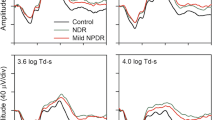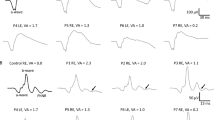Abstract
Nineteen patients with chronic renal failure were studied, oscillatory potentials (OPs) being recorded shortly before and after dialytic treatment. Mean values of either onset latency (O1 latency) and duration of the complex (O1-N4 inter-peak latency) were found to be significantly longer in patients than in controls (p < 0.001). Most of the patients (12) showed a pathological prolongation of latency (>2.5 SD). Amplitude changes also affected OPs, but earlier components were reduced to a lesser degree than the later ones, as shown by statistical analysis. Moreover, seven patients showed an almost complete loss of O3 and O4 peaks. Latency changes may be transiently reversed by dialysis, suggesting a functional impairment of the retinal response; the loss of later components is a more persistent abnormality probably related with a structural damage.
Similar content being viewed by others
References
Yonemura D, Masuda Y, Hatta M. The oscillatory potentials in the electroretinogram. Jpn J Physiol 1963; 13: 129–37.
Ogden TE. The oscillatory waves of the primate electroretinogram. Vision Res 1973; 13: 797–807.
Heynen H, Wachtmeister L, van Norren D. Origin of the oscillatory potentials in the primate retina. Vision Res 1985; 25: 1365–73.
Wachtmeister L. Spatial characteristics of the oscillatory potentials of the electroretinogram. Acta Ophthalmol 1986; 64: 681–90.
Algvere P. Clinical studies on the oscillatory potentials of the human electroretinogram with special reference to the scotopic b-wave. Acta Ophthalmol 1968; 46: 993–1024.
Muller W, Gaub J, Spittel U, Duck KH. Oscillatory potentials in cases of systemic hypertensions. Doc Ophthalmol Proc Ser 1984; 40: 167–71.
Gur M, Zeevi YY, Bielik M, Neumann E. Changes in the oscillatory potentials of the electroretinogram in glaucoma. Curr Eye Res 1987; 6(3): 457–66.
van der Torren K, van Lith G. Oscillatory potentials in early diabetic retinopathy. Doc Ophthalmol 1989; 71: 375–79.
Speros P, Price J. Oscillatory potentials: History, techniques and potential use in the evolution of disturbances of retina circulation. Surv Ophthalmol 1981; 25: 237–52.
Easterbrook M, Mortimer GB. Ocular signs in chronic renal failure. Br J Ophthalmol 1970; 54: 724–28.
Bar S, Savir H. Renal retinopathy: The renewed entity. Metabol Pediatr Syst Ophthalmol 1982; 6: 33–39.
Lakhampal V, Schocket SS, Jiii R. Deferoxamine (desferal)-induced toxic retinal pigmentary degeneration and presumed optic neuropathy. Ophthalmology 1984; 91: 443.
Kojima M, Zrenner E. Off-components in response to brief light flashes in the oscillatory potential of the human electroretinogram. Graefes Arch Klin Exp Ophthalmol 1978; 206: 107–20.
Kergoat H, Lovasik JV. The effects of altered retinal vascular perfusion pressure on the withe flash scotopic ERG and oscillatory potentials in man. Electroenceph Clin Neurophysiol 1990; 75: 306–22.
Peachey NS, Alexander KR, Derlacki DJ, Bobak P, Fishman GA. Effects of light adaptation on the response characteristics of human oscillatory potentials. Electroenceph Clin Neurophysiol 1991; 78: 27–34.
Coupland SG. A comparison of oscillatory potential and pattern electroretinogram measures in diabetic retinopathy. Doc Ophthalmol 1987; 66: 207–18.
Hughes JR, Roxe DM, del Greco F, et al. Electrophysiological studies of urmic patients: comparison of peritoneal dialysis and haemodialysis. Clin Electroencephalogr 1980; 11: 72–82.
Rossini PM, Di Stefano E, Di Paolo B, Albertazzi A. Multimodality evoked potentials in patients with chronic renal failure: early diagnosis of central nervous system. In: Morocutti C, Rizzo P, eds. Evoked potentials: Neurophysiological and clinical aspects. Amsterdam: Elsevier, 1985: 391–99.
Raskin NH, Fishman RA. Neurologic disorders in renal failure (second of the two parts). N Engl J Med 1976; 294(4): 204–10.
Hamed LM, Winward KE, Glaser JS, Schatz NJ. Optic neuropathy in uremia. Am J Ophthalmol 1989; 108: 30–35.
Ichimaru K, Horie A. Microangiopathic changes of sub-epidermal capillaries in end-stage renal failure. Nepron 1987; 46: 144–49.
Cohen SN, Syndulko K, Rever B, Kraut J, Coburn J, Tourtellotte WW. Visual evoked potentials and long latency event-related potentials in chronic renal failure. Neurology 1983; 33: 1219–22.
Komsuoglu SS, Metha R, Jones LA, Harding GFA. Brainstem auditory evoked potentials in chronic renal failure and maintenance hemodialysis. Neurology 1985; 35: 419–23.
Author information
Authors and Affiliations
Rights and permissions
About this article
Cite this article
Polo, A., Lazzarino, L., Pitzorno, F. et al. Retinal oscillatory potential abnormalities in patients with chronic renal failure, before and after dialytic treatment. Doc Ophthalmol 82, 257–265 (1992). https://doi.org/10.1007/BF00160773
Accepted:
Issue Date:
DOI: https://doi.org/10.1007/BF00160773




